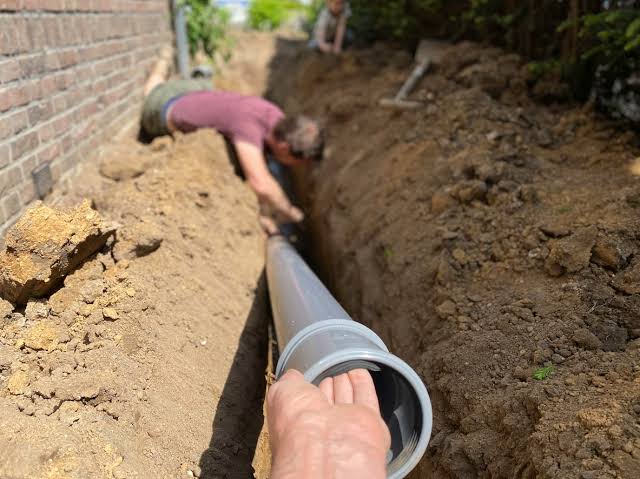A sewer line is a critical component of a property’s plumbing system, responsible for transporting wastewater away from homes and businesses. Over time, these lines can deteriorate or become damaged, necessitating a sewer line replacement. Understanding the reasons for replacing a sewer line can help you recognize potential issues early and take appropriate action to maintain your plumbing system’s functionality.
Common Causes of Sewer Line Damage
Several factors can contribute to the damage and eventual failure of sewer lines. Identifying these causes can help in determining whether a sewer line replacement is necessary.
Age and Wear
One of the most common reasons for sewer line replacement is the age of the pipes. Older sewer lines, particularly those made from materials like clay or cast iron, can deteriorate over time. As these materials age, they can become brittle, crack, or collapse, leading to significant plumbing issues.
Tree Root Intrusion
Tree roots are naturally attracted to the moisture and nutrients in sewer lines. They can infiltrate small cracks or joints in the pipes, causing blockages and damage. Over time, the roots can grow larger, exacerbating the problem and leading to the need for a full sewer line replacement, warns Key Home Sales & Management experts.
Corrosion
Corrosion is a major issue for metal sewer lines, such as those made from cast iron. The constant exposure to moisture and chemicals in wastewater can cause the metal to corrode and weaken. This process can lead to leaks, blockages, and eventually, the failure of the sewer line.
Ground Shifting and Settling
Natural ground movements, such as soil settling or shifting, can put pressure on sewer lines and cause them to crack or break. This is particularly common in areas with expansive clay soils or regions prone to earthquakes. Ground movement can lead to misaligned or broken pipes that require replacement.
Blockages and Backups
Frequent blockages and backups in the plumbing system can indicate a significant issue with the sewer line. While minor blockages can often be cleared with cleaning, persistent problems may suggest that the sewer line is damaged or deteriorating, necessitating replacement.
Signs That a Sewer Line Needs to Be Replaced
Recognizing the signs of a failing sewer line can help you address issues before they lead to extensive damage or costly repairs.
Frequent Clogs and Slow Drains
If you experience frequent clogs or slow drains throughout your home, it may indicate a problem with the main sewer line. Multiple clogs occurring simultaneously in different fixtures suggest that the issue lies deeper in the plumbing system.
Foul Odors
Sewer lines are designed to keep wastewater and associated odors contained. If you notice foul smells coming from your drains or around your property, it could indicate a crack or break in the sewer line, allowing gases to escape.
Soggy or Lush Patches in the Yard
A leaking sewer line can cause water to seep into the surrounding soil, leading to unusually soggy or lush patches in your yard. This excess moisture can create an ideal environment for plant growth, resulting in greener, more vigorous vegetation in affected areas.
Mold and Mildew
Leaks in the sewer line can lead to excess moisture in your home, promoting the growth of mold and mildew. If you notice persistent mold or mildew problems, particularly in your basement or around your plumbing fixtures, it may be due to a sewer line issue.
Cracks in Foundation or Walls
With epoxy injection crack repair, you can address the issue promptly, avoiding more extensive and costly repairs in the future. This method is particularly effective for narrow cracks, where other repair techniques might not be as successful.
Significant leaks or ground shifting caused by a damaged sewer line can lead to cracks in your home’s foundation or walls. These structural issues are serious and require immediate attention to prevent further damage.
Foundation wall crack repair is crucial in addressing these problems. Ignoring cracks in the foundation can lead to extensive structural damage, escalating repair costs, and potential safety hazards. Professional inspection and timely repairs can help maintain the integrity of your home, ensuring a safe and stable living environment.
The Process of Sewer Line Replacement
Understanding the process of sewer line replacement can help you prepare for the work involved and what to expect during the repair.
Inspection and Diagnosis
The first step in sewer line replacement is a thorough inspection and diagnosis. Plumbers often use video camera inspections to assess the condition of the sewer line and identify the exact location and extent of the damage.
Excavation and Removal
Traditional sewer line replacement involves excavating the area around the damaged pipe to remove and replace it. This process can be disruptive and time-consuming, especially if the sewer line runs under driveways, sidewalks, or landscaped areas.
Trenchless Replacement
In some cases, trenchless sewer line replacement methods can be used. These techniques, such as pipe bursting or pipe lining, minimize excavation and disruption by replacing the pipe through small access points. Trenchless methods can be quicker and less invasive than traditional excavation.
Testing and Restoration
Once the new sewer line is installed, it will be tested to ensure it functions correctly and is free of leaks. After testing, the excavation site will be restored, including filling trenches and repairing any disturbed surfaces.
Conclusion
Sewer line replacement may be necessary due to age, tree root intrusion, corrosion, ground shifting, or persistent blockages. Recognizing the signs of a failing sewer line, such as frequent clogs, foul odors, soggy patches in the yard, mold growth, and foundation cracks, can help you address issues promptly. Understanding the replacement process, from inspection to restoration, can prepare you for the work involved. By addressing sewer line problems early, you can maintain your plumbing system’s efficiency and prevent costly repairs.






